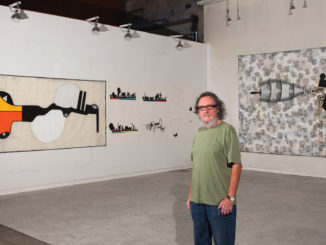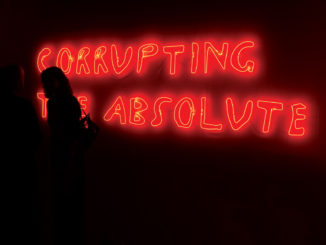 Art in Public Places is a program of the Miami-Dade County Department of Cultural Affairs dedicated to promoting creative art projects with the purpose of improving the visual quality of Miami-Dade County public spaces. For the last 35 years, the outcomes of the program have succeeded in transforming ordinary civic areas into artistic sites that not only have enriched the artistic dimension of our public environment for residents and visitors, but also have contributed a big deal in consolidating the foundations of the county’s artistic heritage.
Art in Public Places is a program of the Miami-Dade County Department of Cultural Affairs dedicated to promoting creative art projects with the purpose of improving the visual quality of Miami-Dade County public spaces. For the last 35 years, the outcomes of the program have succeeded in transforming ordinary civic areas into artistic sites that not only have enriched the artistic dimension of our public environment for residents and visitors, but also have contributed a big deal in consolidating the foundations of the county’s artistic heritage.
The program was started in 1973, as one of the nation’s first public art programs. It relies in an ordinance that allocates 1.5% of every construction cost destined to new county buildings, to purchasing, or commissioning monumental artworks to recognized national and international artists. Art in Public Places is overseen by a citizens’ Trust, appointed by the Board of County Commissioners. The Trust receives recommendations on acquisitions and commissions from a professional advisory committee, composed of independent professionals working in the fields of art, art history and architecture.
Today, with a collection of more than 700 works of art installed countywide, Art in Public Places marks can be found at major urban sites such the Miami International Airport, the Metrorail and Metromover stations, the Port of Miami, and the MetroZoo, as well as at fire stations, libraries, police stations, public housing developments, and community health centers. This program has literally become a public “art museum” by treasuring the work of more than fifty local, national and international artists.
“In 2004, the voters of our community approved the visionary Building Better Communities bond program, committing to the investment of $2.9 billion in more than 300 neighborhoods and regional capital projects over the next 15 years.” Said Michael Spring, Director of Miami-Dade County Department of Cultural Affairs. “As all of these projects continue to improve and transform our community, Miami-Dade Art in Public Places will build upon its 35 year history of excellence in commissioning world-class works of public art that enrich our built environment while educating and inspiring our residents and visitors.”
One of the county locations with the highest concentration of public art is the Miami International Airport. Encompassing a variety of artistic concepts and diverse medias, the monumental installations can be seen throughout the facilities’ public areas. Most of the works at MIA celebrate Miami’s unique natural environment, while few others represent the city’s cultural diversity and artistic heritage. One way or another, the art at the Miami International Airport have welcomed millions of visitors throughout the years to a city that it is now known as the art capital of the Americas.
Miami artist Barbara Neijna has created an environment that is unique to South Florida and, much like the Everglades, her 2007 installation in Concourse J, Foreverglades, “is like no other.” Text from Margory Stoneman Douglas’ River of Grass is embedded into 65,000 sq. ft. of terrazzo floor running throughout the concourse. Pre-cast stone bas-relief panels interspersed with ribbons of glass, which symbolize flowing water and swaying reeds of grass, are seamlessly integrated into the architecture. Expansive curtain wall windows shower the concourse with brilliant color and highlight the hundreds of small, abstracted photographic images of South Florida intermixed throughout the terminal. Working in South Florida since 1962, Niejna has produced a large body of sculpture ranging from small wall-mounted objects to monumental freestanding geometric forms.
Also from 2007 is Brad Goldberg’s Coral Eden. The work is composed of two massive stonewalls, each measuring approximately 30 feet wide by 90 feet high. The imagery, derived from a series of macro-photographs of brain coral, is carved in Travertine marble from Italy. The coral relief is quite shallow at the base of the wall and increases in depth as the stone rises, allowing the coral pattern to subtly emerge through light and shadow. As passengers gaze up at the expansive wall, the increasing depth of the forms will suggest a view upward from the bottom of the ocean toward the atmosphere and sun. Based in Dallas, Texas, Brad Goldberg is an artist who sees his work as a fusion between sculpture, the landscape and the built environment.
At the International Baggage Claim Area of South Terminal is Norie Sato’s Ghost Palms, also from 2007. Ghost Palms combines the organic structure of palm trees with the clean lines of the terminals’ architecture, producing a subtle dichotomy between the natural and man made. Sited at five locations along the 300 foot-long glass interior wall of the International Baggage Claim, Ghost Palms uses softly colored iridescent glass to create a space full of oversized “stained glass”. Sato has also designed a terrazzo floor for the baggage claim area, which mirrors the reflection of the glass windows and creates the illusion of shadows cast on the floor by the palm images. Norie Sato is a renowned Seattle-based artist with experience in planning diverse projects, from small community-based plans to larger public spaces. Her work includes public art plans for transit in Portland, Phoenix, and Seattle; urban corridors in Seattle and Boise; and airports in Denver, Miami, and Seattle.
Continuing towards Concourse H is Robert Calvo’s Flight Patterns created in 1997. With this 880-foot-long floor mural, Robert Calvo explored notions of time, travel, distance, location, and discovery. The artist addressed the tension between the impulse to travel and the need to return home, as his floor imagery recurred to maps, celestial cycles, and astrology. On the stairways to the third level, Calvo inlaid evocative proverbs and poems, inviting the traveler to upper areas of the concourse. The work was done in more than ten colors of terrazzo, to create a thoughtful environment tending to balance “transience and nomadism with domesticity and sense of place” as defined by the artist himself.
One of the most outstanding collaborative projects is located high above the concourse floor adjacent to clerestory windows. Aqua / Botanica, from 1997 is a sculptural glass installation reflecting, transmitting, and modulating natural light. Oregon artist Ed Carpenter collaborated with architect Mike McCulloch and artist John Rogers to develop a visual system in which progressions of interval, line, and contour lead travelers through the concourse and unify the space. In this wonderful installation, Florida’s intense sunlight filters through chemically treated “dichroic” glass to create fluid “light paintings” on the undulating ceiling and upper concourse walls. At night, lighting installed beneath the glass structures creates a different but equally dramatic effect. Ed Carpenter received his education from the University of California at Santa Barbara and Berkeley. He has served as the Metropolitan Arts Commissioner for Portland, Oregon where he also founded the Public Art Advisory Committee.
In 2003, Miami-Dade Art in Public Places commissioned another monumental project to Chicago artist John David Mooney. Miami Wave, a two-part installation sited in the central island of the entrance and Toll Collection Plaza, was inspired by Miami’s light and water. Mooney envisioned Miami Wave as a place of welcome and memory for those entering and exiting the area. In this project, Mooney’s creative use of color and line take advantage of the kinetic qualities of a wave moving through space and time, transmitting to the viewer a special sense of Miami’s place in the universe.
A total of eleven monumental artworks have been installed at Miami International Airport by Art in Public Places. Unfortunately, we don’t count with enough editorial space to feature them all, but we will continue following the traces of Art in Public Places throughout Miami-Dade County in future editions. Stay tune for more re-discoveries.



Be the first to comment